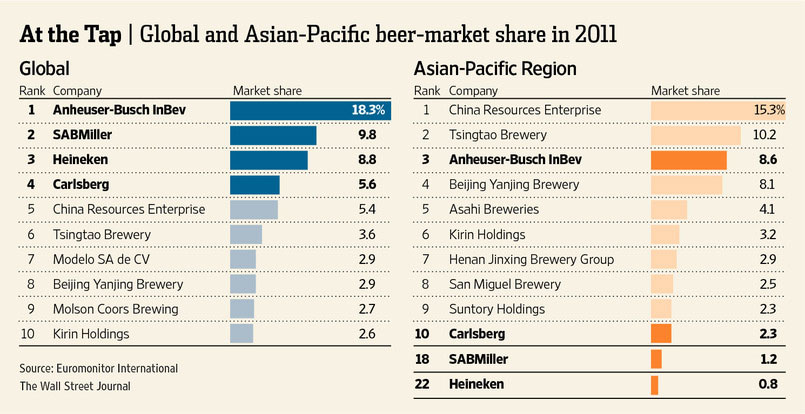“How much do I have to pay you to give up your rights?”
That’s the question AB-InBev, the present owner of the Budweiser beer brand, asked its Czech rival, the state-owned brewery Budweiser Budvar. The dispute over the Budweiser trademark has been raging for over 100 years and AB-InBev seems to have been keen on settling the issue once and for all.
But according to international media Budweiser Budvar’s asking price was way too much for AB-InBev (or, looked at differently, AB-InBev offered too little) and talks collapsed in December 2012.
It must have been a scene to behold: the world’s brewing goliath, AB-InBev, and its puny competitor Budweiser Budvar getting together for a “let’s divide the world” meeting.
As in some Cold War movie, they would have stood around a sandbox of the world’s beer markets. Each would have been armed with a rake and plenty of flags, ready to place them where they currently hold the exclusive rights to the Budweiser brand.
It was in 1939 when the two brewers last agreed on a global settlement. They then formed a pact that gave Anheuser-Busch sole rights to the name Budweiser in all American territories north of Panama. However, the accord did not last long as the two companies expanded exports to new markets.
This time the sandbox would have been awash in Budvar flags as the Czech Budweiser, in the meantime, has managed to obtain exclusive rights in 68 countries, mostly in Europe, but also in eleven Asian countries, Japan, Korea, China and Vietnam among them, thus preventing AB-InBev from entering them with its Budweiser brand.
AB-InBev’s goal in this meeting would have been – and we are not imagining anything extravagant – to persuade Budvar to get completely out of the sandbox or at least decamp in Asia-Pacific.
Canadean, a market research company, says that AB-InBev currently has just under 10 percent of the Asian beer market, almost all in China. Budweiser’s share of the Asian market is just over 1 percent. The bulk of AB-InBev’s volume in Asia is from the Harbin and Xuejin brands in China. China accounts for almost 75 percent of all Budweiser volume in Asia and Budweiser has just over 1.5 percent of the Chinese market. Other important markets for Budweiser are Hong Kong (where it has 5 percent share); India (where it has around 1 percent of the market); and South Korea (where it has just under 1percent of the market). It is also available in Japan and Taiwan, but the share is under 1 percent and there are negligible volumes in Indonesia, Vietnam and the Philippines.
While Canadean reckons that the Asian beer market is currently growing at around 6 percent per year and will gradually slow to around 4 percent per year by 2017, Plato Logic, another research company, forecasts that international premium brands like Budweiser will grow over 7 percent each year until 2020. In volume terms, international premium brands are expected to reach 45 million hl in Asia in 2020 from 21.5 million hl in 2010. The major growth markets for international premium brands are China, followed by Vietnam, India, Australia and Thailand.
In 2010, Budweiser was the major international premium brand with sales of about 6 million hl right across Asia. The Heineken brand came a close second with slightly under 6 million hl. Carlsberg and Mexican Corona Extra ranked third and fourth, selling about 1 million hl each, according to Plato Logic.
If the American Budweiser wants to partake of the growth in the Asia-Pacific, it has to move beyond China and enter markets which are presently controlled by Budweiser Budvar. The Czechs sell hardly any volumes in these markets at the moment as Czech beer is way too bitter for Asian tastes, but they enjoy the benefit of exclusivity rights, which would have been a dead pledge in their negotiations with AB-InBev.
Budweiser Budvar’s boss Jiri Bocek told media in December 2012 that AB-InBev was not interested in sharing the brand name with the Czechs. If exclusivity for the American Budweiser all around the world was AB-InBev’s ultimate goal, then they ought to have made the Czechs an offer they could not refuse.
Of course, AB-InBev did not say what they offered the Czech. But if we had been the Czechs, we would have bargained for a percentage share, say 15 percent of AB-InBev’s future Budweiser earnings in all markets over a period of ten, twenty, or even forty years. We would not have accepted anything less.
Having failed to reach a settlement, the legal wrangles between AB-InBev and Budweiser Budvar will continue. Today, the dispute is being waged through 61 suits in 11 countries, it was reported.
At the end of the day, Budweiser Budvar has nothing to lose but everything to gain from these legal disputes as it provides the smaller Budweiser Budvar with protection against competition from AB-InBev. Mr Bocek was quoted as saying that it is essential that Budvar uses all the legal leverage it can. "We have a right to exist," he said.
As we have always said, the only way for AB-InBev to resolve these disputes is to acquire Budvar – for way more than it’s worth. However, this option seems further off than ever.


